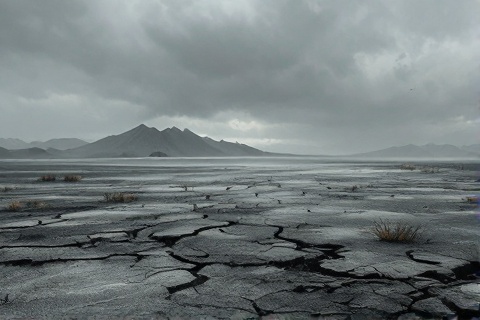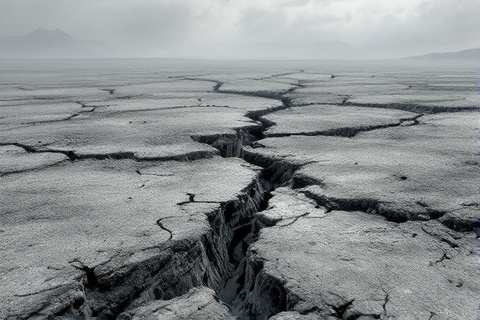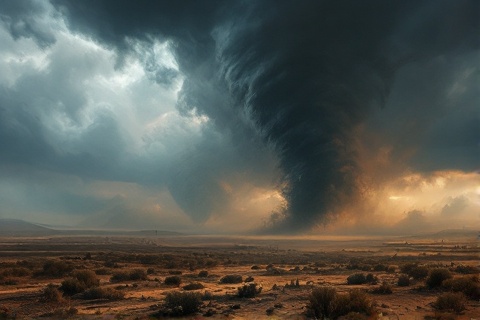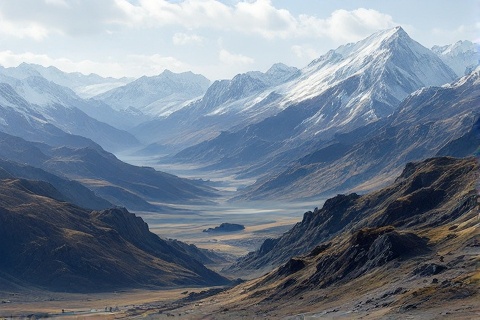
Anfauglith: The Ashen Plains of Middle-earth
Unveiling the Tragedy and Legend Behind Tolkien's No-man's Land
The Geography of Anfauglith

Anfauglith stood as one of the most expansive plains in the ancient realm of
Beleriand, stretching across the northern regions beneath
the imposing Iron Mountains. This vast territory played a crucial role in the
geographic and strategic landscape of the First Age, serving
as a natural boundary between the realms of the Noldor and
Morgoth's fortress of Angband.
Before its transformation into a desolate wasteland, this region was known as
Ard-galen, a name that reflected its original nature as a verdant plain. The
grasslands of Ard-galen flourished under the light of the Two Trees, and later
the Sun, creating a vibrant ecosystem that stood in stark contrast to the
darkness of Thangorodrim to the north.
The sheer scale of Anfauglith was remarkable, spanning approximately 200 miles
from its eastern to western boundaries. This tremendous expanse made it one of
the largest continuous geographical features in Beleriand, comparable in size to
the great forests of Doriath and Taur-im-Duinath.
From Ard-galen to Anfauglith
During the earliest days of the First Age, this northern plain flourished as a
verdant grassland teeming with life. The rich grasses of Ard-galen stretched as
far as the eye could see, providing grazing grounds for countless herds and
serving as a natural paradise before the shadow of Morgoth descended upon it.
The catastrophic Battle of Sudden Flame, known in
Sindarin as the Dagor Bragollach, marked the violent transformation of this
once-beautiful land. Morgoth's rivers of flame and vast fires consumed the
grasslands in an inferno that forever changed the nature of the plain, turning
it into a lifeless desert.
Following its devastating transformation, the plain received its new name:
Anfauglith, meaning 'Gasping Dust' in Sindarin. This name change reflected not
only the physical transformation of the land but also served as a grim reminder
of the choking clouds of ash that now characterized this once-fertile region.
The Physical Features of the Ashen Plain

The surface of Anfauglith became entirely covered in thick layers of gray ash
and volcanic dust, remnants of Morgoth's devastating fires during the Dagor
Bragollach. These ashen deposits, continuously replenished by the fires of
Thangorodrim, created an otherworldly landscape that bore no resemblance to its
former beauty.
The transformation of Anfauglith was so complete that no living thing could
thrive in its poisoned soil. Where once grew lush grasses, now lay only sterile
earth, making it impossible for even the hardiest plants to take root in this
barren wasteland.
Throughout the plain, deep fissures and cracks scarred the earth, testament to
the intense heat and geological upheaval caused by Morgoth's fires. These
chasms, some deep enough to swallow an unwary traveler, added to the treacherous
nature of the terrain.
Rising from the ashen plains, occasional rocky outcrops broke the monotony of
the flat landscape. These stone formations, some natural and others created by
the violent reshaping of the land, served as the only landmarks in this
otherwise featureless expanse.
Climate and Environmental Conditions

Above Anfauglith, the skies remained perpetually darkened by the malevolent
influence of Morgoth. The smokes and vapors from Angband combined with the
natural gloom of his presence created a permanent twilight that rarely lifted,
contributing to the plain's forbidding atmosphere.
Fierce winds regularly swept across the exposed plain, lifting the loose ash and
dust into choking clouds that could suffocate travelers caught in their path.
These dust storms made crossing Anfauglith particularly treacherous, as
visibility could be reduced to nothing in moments.
The climate of Anfauglith exhibited extreme temperature variations
characteristic of desert environments. The ashen surface absorbed and reflected
heat differently than the original grassland, creating scorching days and
bitterly cold nights that added to the inhospitable nature of the region.
Borders and Surrounding Lands

The northern boundary of Anfauglith was formed by the formidable Iron Mountains,
or Ered Engrin, which housed Morgoth's fortress of Angband. These mountains cast
their long shadow over the plain, both literally and figuratively, as they
contained the source of much of the evil that had transformed the region.
To the south, the highlands of Dorthonion created a natural barrier between
Anfauglith and the forests of Beleriand. These highlands, later known as
Taur-nu-Fuin after their corruption by Morgoth, marked
the beginning of the territories still contested by the free peoples of
Middle-earth.
The western reaches of Anfauglith terminated near the crucial Pass of Sirion,
where the great river cut through the mountains. This strategic location
remained vital throughout the Wars of Beleriand as one of the few passages
through which armies could move between the northern and southern regions.
Extending eastward, Anfauglith stretched toward the March of Maedhros, where the
sons of Fëanor maintained their vigilant watch against
Morgoth's forces. This eastern frontier represented one of the most heavily
fortified borders of the plain, crucial to the defense of East Beleriand.
Legacy in Middle-earth's Geography
Anfauglith remained a desolate wasteland until the catastrophic War of
Wrath at the end of the First Age. When the
Valar finally moved against Morgoth, this plain became the site
of the greatest battles ever fought in Arda, ultimately leading to its
submergence beneath the waves along with most of Beleriand.
Throughout its existence as a corrupted land, Anfauglith served as a strategic
buffer zone between Morgoth's realm of Angband and the lands of Beleriand to the
south. This no-man's land became the site of numerous battles and skirmishes,
most notably the tragic Nirnaeth Arnoediad, or Battle of Unnumbered Tears.
The transformation of Anfauglith from Ard-galen represents one of the most
dramatic and permanent changes to Middle-earth's landscape in its history. The
scope of this transformation demonstrated the devastating power of Morgoth and
served as a lasting reminder of the cost of his evil, recorded in the annals of
The Silmarillion for all time.
